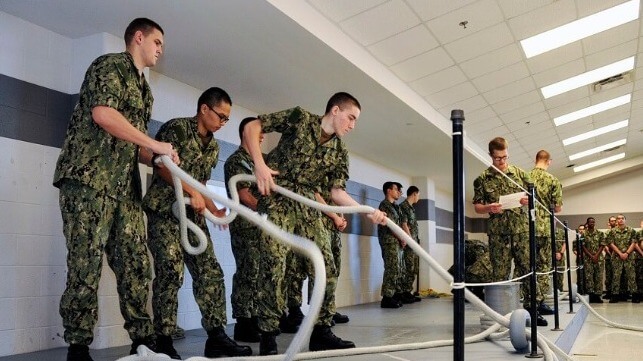U.S. Navy Adds Two Weeks to Boot Camp to Fix Shortcomings in Training

The U.S. Navy has announced the first major change to its boot camp training for new recruits in 20 years. With the revision of the curriculum at Naval Station Great Lakes, home of Recruit Training Command, newly-enlisted sailors will receive an additional two weeks of preparation for firefighting, damage control and decent shipboard behavior.
Recruit Training Command has run an eight-week program for the last two decades, but the Navy's leadership has noticed trends with new enlisted sailors which it would like to address, and the extra two weeks are structured to address these issues.
The "hard skill" deficiencies include a troubling lack of readiness for marine firefighting, as demonstrated by the destruction of the amphib USS Bonhomme Richard at a pier in San Diego in July 2020. A "Major Fires Review" released in January 2021 concluded that "ineffective learning . . . and training" were among the long-term issues contributing to a lack of change in the Navy's readiness to fight fires. To address this deficiency, new recruits will now go through extra real-life firefighting and damage control training during their final two weeks at boot camp.
However, much of the extra time will be devoted to "soft skills" and the transition into military life. A new "Sailor for Life" training module focuses on life skills and acculturation, making sure that new recruits understand how they will be expected to behave in the Navy. This includes treating shipmates with respect, regardless of gender or race, and acting in accordance with the Navy's core values.
"Our goals are to ensure that when the recruits graduate, these initiatives connect them to each other, they are engaged with being a part of the Navy, being a part of the organizational culture,” said Rear Adm. Jennifer Couture, the commander of Naval Service Training Command, speaking to Navy Times on Friday.

that matters most
Get the latest maritime news delivered to your inbox daily.
An additional goal is to centralize more of the training process at Naval Station Great Lakes, taking back some of the elements that have historically been administered out in the fleet. The objective is to deliver enlisted sailors who are closer to "ready to go" on arrival.
“The additions were the result of fleet feedback and the hard work of all the staff here at RTC and throughout the Navy,” said Lt. Cmdr. Katy Bock, military training director, Recruit Training Command. “Every recruit now graduates with more tools and skills to make them more effective and combat ready sailors."
